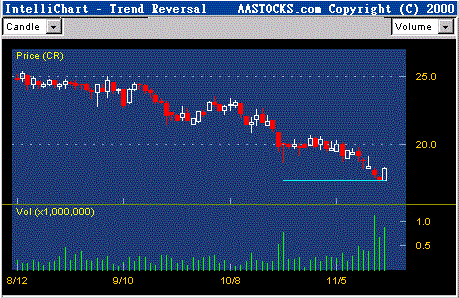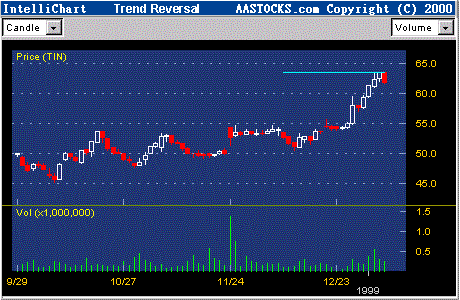|
|
|
 |
|
Technical Trading Strategies
Technical analysts and traders believe that certain
stock chart patterns and shapes are signals for profitable trading opportunities. Many
professional and amateur traders claim that they consistently make trading profits by
following those signals. In this chapter we introduce eight types of stock patterns and
the corresponding trading strategies, that, according to our extensive historical tests, give the trader an advantage.
Candle Stick Trend
Reversal
A candle stick chart is a good presentation of a stock’s momentum. On a
candlestick chart, one can easily see the secession of up days, down days and
sudden changes in the stock pattern. The following figure is an example of what
is sometimes called "First Sunny Day", a typical buy pattern.

Figure 11. A Trend Reversal pattern. After
a long, long decline, the stock suddenly goes up in significant magnitude. Furthermore, it
closes much higher above its open. This "First Sunny Day" sends a short-term buy signal.
The trading strategy for a "First Sunny Day" pattern is to buy the stock and hold until
it recovers the range lost by the recent secession of down days, or to cut losses if it
drops back to the prior day's low. This pattern usually signals a very good profit-risk
ratio.

Figure 12. This is a short-term Trend-Reversal pattern. After a long, long rise,
the stock suddenly drops; its close is much lower than its open. This pattern hints that
something has suddenly gone wrong with the stock. This so-called "Sudden Cloudy
Day" pattern indicates one should sell the stock without delay.
In this example of the, "Sudden Cloudy Day"pattern, the trading strategy is to
short
the stock and hold it until it retraces the recent secession of up days or to cut losses
if it breaks the previous day's high.
For longer-term trend-reversal patterns, we often look for the "Shooting
Star"; as shown in the example above. We also look for the "T-Shape"which
signals a bounce-back buy signal.

Figure 13. The stock price soared considerably in the past few days. At present, it
shoots up, as if exhausting all its energy. This Shooting Star pattern hints that the
market has lost confidence in the further potential of the stock, indicating a likely
downturn.

Figure 14. The stock price dropped over several days. Presently, it drops
precipitously, then bounces back to close near the open, forming a "T" shape.
This may indicate that the market finally has finally decided the stock has
dropped enough, with many bullish traders and investors coming to the rescue.
|
